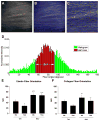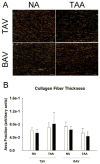Mechanism of aortic medial matrix remodeling is distinct in patients with bicuspid aortic valve
- PMID: 23764410
- PMCID: PMC3800488
- DOI: 10.1016/j.jtcvs.2013.04.028
Mechanism of aortic medial matrix remodeling is distinct in patients with bicuspid aortic valve
Abstract
Objectives: Patients with bicuspid aortic valves (BAV) are predisposed to developing ascending thoracic aortic aneurysms (TAA) at an earlier age than patients who develop degenerative TAAs and have a tricuspid aortic valve (TAV). The hypothesis tested is that BAV-associated aortopathy is mediated by a mechanism of matrix remodeling that is distinct from that seen in TAAs of patients with tricuspid aortic valves.
Methods: Aortic specimens were collected during ascending aortic replacement, aortic valve replacement, and heart transplants from nonaneurysmal (NA) donors and recipients. Matrix architecture of the aortic media was assessed qualitatively using multiphoton microscopy followed by quantification of collagen and elastin fiber orientation. α-Elastin was determined and matrix maturity was assessed by quantifying immature and mature collagen and lysyl oxidase (Lox) expression and activity in aortic specimens. Matrix metalloproteinase-2/9 activity was quantified in aortic smooth muscle cells.
Results: Elastin and collagen fibers were more highly aligned in BAV-NA and BAV-TAA cases than in TAV-TAA cases, whereas TAV-TAA cases were more disorganized than TAV-NA cases. α-Elastin content was unchanged. Immature collagen was reduced in BAV-NA and BAV-TAA cases when compared with TAV-NA and TAV-TAA cases. Mature collagen was elevated in TAV-TAA cases compared with TAV-NA and BAV-TAA cases. There was a trend toward elevated Lox gene expression and activity and matrix metalloproteinase-2/9 activity for TAV-TAA, BAV-NA, and BAV-TAA specimens.
Conclusions: The highly aligned matrix architecture in patients with BAVs indicates that wall remodeling is distinct from TAV-TAA. Altered matrix architecture and reduced collagen maturity suggest that the effector molecules mediating the remodeling of TAAs are different in BAV and TAV cases.
Copyright © 2014 The American Association for Thoracic Surgery. Published by Mosby, Inc. All rights reserved.
Conflict of interest statement
There are no conflicts of interest to disclose.
Figures





References
Publication types
MeSH terms
Substances
Grants and funding
LinkOut - more resources
Full Text Sources
Other Literature Sources
Medical
Miscellaneous

